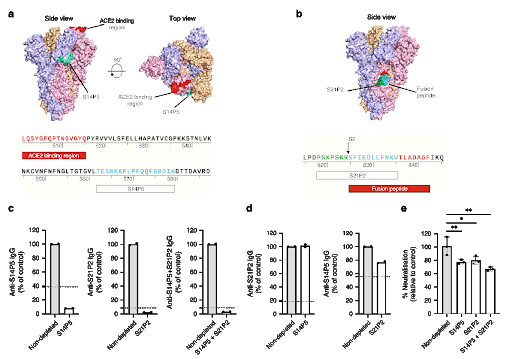
Localisation and sequences of a SARS-CoV-2 specific S14P5 and b pan-CoV S21P2 epitopes on spike (S) protein (PDB: 6VSB) are shown. Each S monomer is denoted as either pink, blue or orange. c–e Pooled sera of COVID-19 patients (n = 6) were added to plates coated with the corresponding peptides to deplete specific antibodies. (Source: Poh et al., 2020).
Identification of immunogenic SARS-CoV-2 epitopes and peptides are critical to the design of new diagnostics and potential vaccines. Researchers from A*Star and other Singaporean research institutions aimed to identify potential B cell epitopes recognised by Abs from convalescent COVID-19 patients.
Using neutralisation assays researchers identified two immunodominant epitopes S14P5 and S21P that were recognised by Abs from convalescent patients. Both epitopes are part of the SARS-CoV-2 S glycoproteins, “S14P5 was shown to localise in close proximity to the receptor binding domain (RBD), whereas S21P2 covers part of the fusion peptide.” Researchers hypothesis that Ab binding to S14P5 epitope “may sterically hinder binding to the ACE2 receptor, thereby abolishing virus infection”, while binding to S21P2 could directly affect viral fusion. They acknowledge that two linear epitopes represent a small proportion of total anti-S-specific Ab responses, however, they showed that depletion of Abs specific to S14P5 and S21P2 resulted in a > 20% reduction of neutralisation capacity of convalescent sera.
Watch IUIS Webinar by Lisa Ng that describes identification of S145P5 and S21P2 epitopes
Journal Article: Poh et al., 2020. Two linear epitopes on the SARS-CoV-2 spike protein that elicit neutralising antibodies in COVID-19 patients. Nature Communications
Article by Cheleka Mpande










